#intermodal train
Explore tagged Tumblr posts
Text
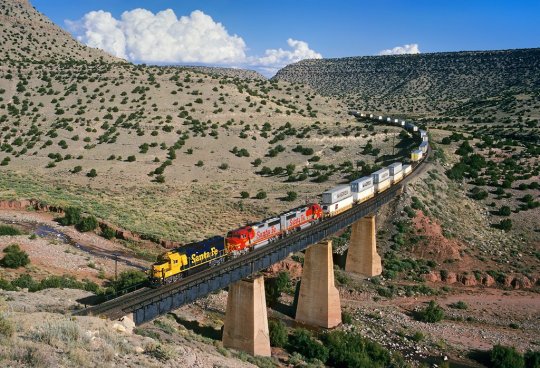
127 notes
·
View notes
Text
youtube
#railfanning#railfan#railroad#railway#railroads#trains#train#finger lakes railway#youtube railfans#csx intermodal#csx railroad#Youtube
3 notes
·
View notes
Text
4K: 1 Hour of trains on the Martinez Subdivision!
youtube
#railfan#union pacific#martinez subdivision#trains#4k#railfanning#youtube#railroad#intermodal trains#train
2 notes
·
View notes
Video
Item last by Greg Brown Via Flickr: Late on a spring evening in May 1998, a Union Pacific intermodal train arrives at Klamath Falls, Oregon. The job is about to cross KLAD crossing, which crews have nicknamed for the local radio station that maintained its studios for many years in an adjacent building. As the northbound approaches, the ancient magnetic flagman merrily warns the world that a train is nearing the crossing. Once ubiquitous along lines of the Southern Pacific, the wig wag signal here is the last one in service on the Shasta Route.
#Klamath Falls#Oregon#Union Pacific#UP#Southern Pacific#SP#wig wag#Magnetic Flagman#Intermodal#Z train#Freight Train#Railroad#Railway#flickr
29 notes
·
View notes
Video
Saturday Sunrise at the Stateline (3 of 3) by Greg Brown Via Flickr: Back in the DINK (Double Income, no Kids) days, we usually went to Klamath Falls for Memorial Day weekend. In 1996, we maintained the tradition. On the way home from work Friday afternoon, we saw Southern Pacific makinq up the Los Angeles bound Swift RoadRailer at Brooklyn Yard in Southeast Portland. The Portland-LA RoadRailer had just entered revenue service a couple of months earlier. I got up before sunrise in Klamath on Saturday morning, hoping to intercept the RoadRailer somewhere. At the time, I didn't know that you could use SP's car tracing 800 number to find the location of the RoadRailer trailers. My plan was to go to the Oregon/California stateline, listen to the scanner, and see what developed. As I left Klamath Falls, I saw a northbound BNSF train entering the SP at Bieber Line Junction. Burlington Northern had been merged with Santa Fe the previous September, but the new BNSF had made no blatant operational changes at Klamath Falls. Trains still ran with cabooses, in deference to the hand throw turnouts on Oregon Trunk sidings. Chatter between BN/BNSF crews was often a good source of information. It would prove to be so today. Not long after I arrived at the stateline, a westbound SP drag came into view. It had four units running elephant style, including a Conrail GE and a Rio Grande tunnel motor. As the train passed, I thought about taking off south and chasing it - until the scanner gave me the traffic report I was waiting for. The SP dispatcher had advised the BNSF train that he would hold at the east end of Klamath Falls Yard for one train before he could enter the main and head for Bend. When that train arrived at Klamath, here's what I heard on the BNSF road channel: BNSF Engineer: Wait 'til you see the train they stuck us for. You won't believe it!" BNSF Conductor: "How so?" BNSF Engineer: "This poor SP is gettin' so hard up, they can't even afford flatcars for their pig trains!" About 25 minutes later, the RoadRailer rolled through Worden, climbed the big fill on the mid-60s line change at the Lake Miller dry lake bed, and passed me. It was the start of a great chase that ended late that morning in the Sacramento River Canyon. In this image, the westbound RoadRailer is approaching the Oregon/California state line. A dozen years earlier, when SP 4449 was enroute to New Orleans, there were at least 100 photographers here.
#Worden#Oregon#Southern Pacific#SP#SP Oregon Division#SP Black Butte Subdivision#Klamath County#Klamath Basin#EMD#Freight Train#Railroads#Railroad#Railway#Trains#Train#Swift RoadRailer#RoadRailer#Intermodal#flickr
4 notes
·
View notes
Text
NS Norfolk Southern SD70ACe & GE locomotives on NS EB stack intermodal, NS Chicago Line, Berea, OH, 9/2023. www.1westproductions.com
#1westproductions#onewestproductions#trains#railroads#trainspotting#railfanning#norfolksouthern#railroad#locomotives#sd70ace#intermodal#ns chicago line
4 notes
·
View notes
Text
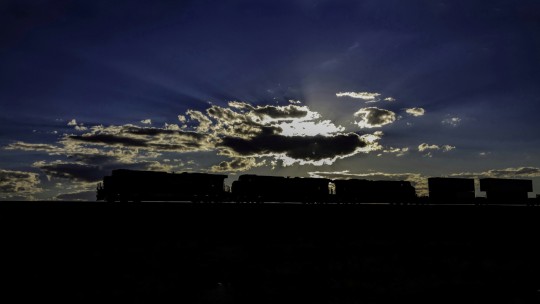
2 notes
·
View notes
Note
Since the MBTA has trains and boats, why are there no services involving a train on a boat? It's doable (roll-on/roll-off train ferries have existed for quite some time), get on it.
What cargo are you moving on mbta trackage that requires a train ferry and are you sure you have a license for that because the main historical use I can find for ro/ro train ferries was during world war 1 when having your materiel need to get loaded and unloaded was inefficient, a problem that has been basically completely solved by the intermodal shipping container
79 notes
·
View notes
Text
types of freight cars
made a whole post to help ppl design stex ocs as the resident freight enthusiast :) while this isn't every freight car in existence, it's definitely a good chunk of them!
FLATCARS
The most basic type of freight car. They’re…well…flat! Designed for carrying bulky loads.

Autorack: Transport automobiles. Can have single, double, or triple levels.
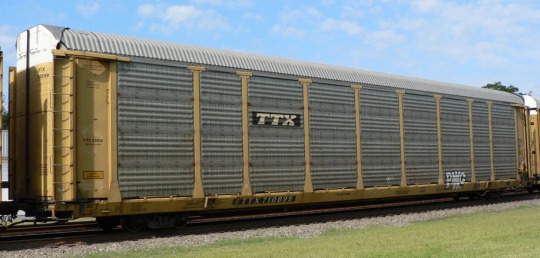
Boom/Idler: Placed in front of a breakdown crane to protect the boom or in front of/behind oversized loads to protect the overhang.
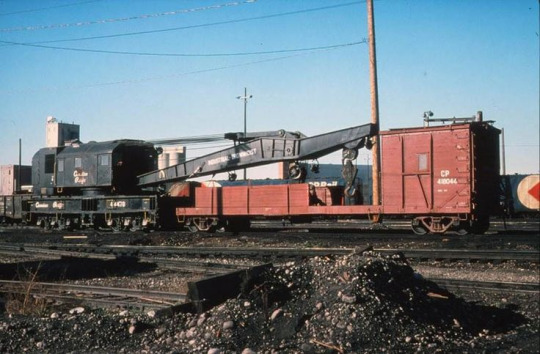
Bulkhead: Have walls (bulkheads) on the end. Used to transport pipe, poles, slabs, and lumber. Prone to derailing when traveling empty and put speed restrictions on the freight train.
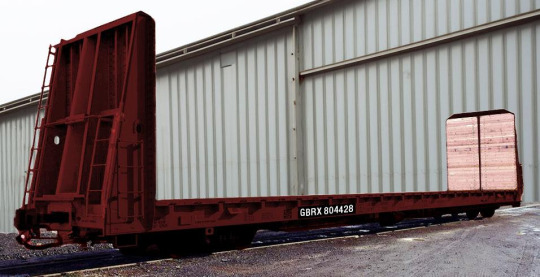
Centerbeam: Carry lumber. Another type is the opera (round) window style. Have to be loaded/unloaded evenly to avoid the car tipping over.

Depressed Center: Used to carry extremely heavy loads such as generators. Have a lowered (depressed) middle section.

Intermodal/Well: Carry semi-truck trailers and containers. Have a lowered bottom (well).

Skeleton/Spine: Very narrow car used to transport lumber. Has stakes on the sides. Spine cars do not have stakes and are often used for intermodal transport.

GONDOLAS
Open-topped cars that generally transport loose goods. Can also be covered. Differ from hoppers in that they have flat bottoms and have to be manually unloaded or put through a rotary dumper.
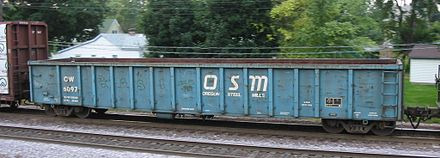
Bathtub: Transport coal. Have rounded bottoms for extra space.
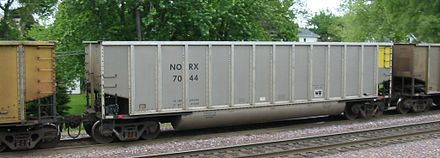
Coil: Carry coils of metal. Can be open or have specialized covers to protect the cargo. Typically considered a subtype of gondola, but can also be a subtype of flatcar as well.

Side-dump: Cars tip sideways to dump loads. Often carry ballast or rocks for railbeds.

HOPPERS
Evolved from gondolas but differ in that they have sloped bottoms and discharge doors. Can be covered or uncovered, and have between two to five chutes. Open cars transport bulk goods such as coal, while covered ones carry food items.

Ore Jenny: A small, specialized hopper designed to carry large loads of iron ore from mines.

BOXCAR
Enclosed cars with side or end doors. Used for bulk commodities and for goods that need to be protected from the weather.
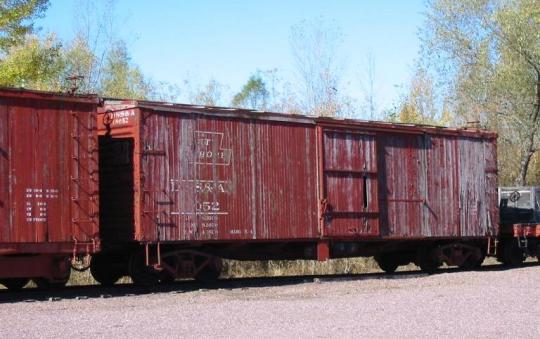
Stock: Used to transport livestock such as cattle, horses, sheep, and poultry. Have ventilated sides for airflow. A variant used to carry fish was attached to passenger trains and was more luxurious.
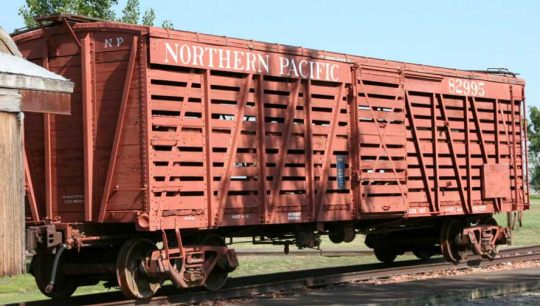
Refrigerator: Insulated and cooled cars used to transport frozen goods.

TANKERS
Used to transport liquids or gases. Can be specialized to carry hazardous materials.

Milk: Specialized tank car variant (as opposed to the boxcar variant) that carries milk. Attached to passenger trains to prevent spoilage.

Pickle: There's pickles in there! The vats were filled with vinegar.

Torpedo: Carry molten iron. Designed to withstand very high temperatures.

Whale Belly: Large tank car with a lowered midsection for additional carrying capacity.

SCHNABEL
These cars are a type all of their own. Used to transport extremely large loads by pinching it between the arms of the car.

119 notes
·
View notes
Text
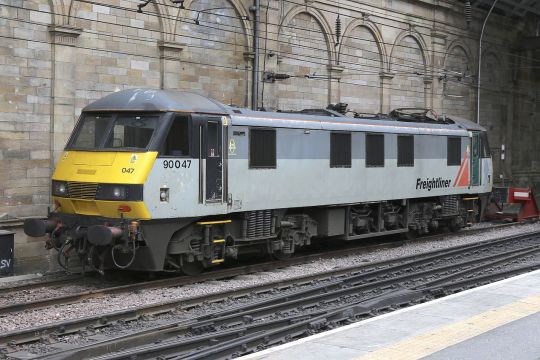
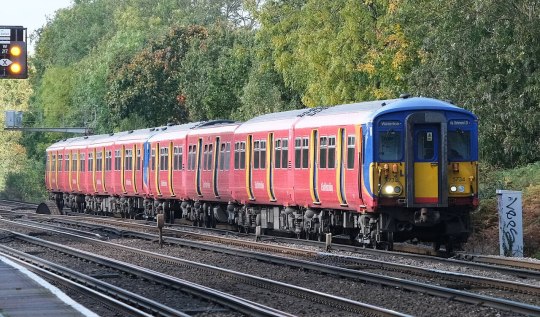
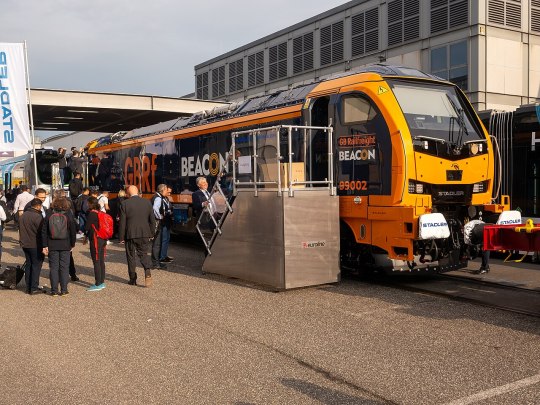

More info below!
Class 90 Manufacturer: BREL (1987-1990) Model: n/a Designed as a modernised version of the Class 87 for both freight and passenger use. Procured due to the impracticality of using Class 91s for freight traffic.
Class 455 Manufacturer: BREL (1982-1985) Model: BR Second Generation (Mark 3 Derived) Designed as a passenger commuter train for the Southern region, using the same bodyshell as the Class 317 and 318. To save on costs, the /7 subclass uses a carriage from a Class 508, which were shortened when moved to Liverpool.
Class 99 Manufacturer: Stadler (?) Model: Euro Dual A diesel and electric bi-mode locomotive designed to replace Class 66s on intermodal freight.
Class 88 Manufacturer: Vossloh (2015-2016), Stadler (2016) Model: Euro Dual Designed as a bi-mode variant of the Class 68. Used for freight traffic over primarily electrified routes.
20 notes
·
View notes
Text
Trains in Anime - Arcane Season 2
As you may have heard, the second season of Arcane is out. Arcane is a complex and amazing show about love and loss, about power and class, about friends and family, about playing god and being god. It’s amazing, it’s beautiful, it’s heartbreaking, it’s an ad for a game you should never ever play, it sets the benchmark for what animation can be and do in this decade and beyond.
But most importantly, it has trains. Let's talk about them.
Prison Train
Apart from a few new angles on the funicular we already know from season 1 and some mine carts, there are two interesting train-like thingies in this season. The first one appears in episode 4 and is used to bring prisoners and main characters to the prison island. And it's weird.
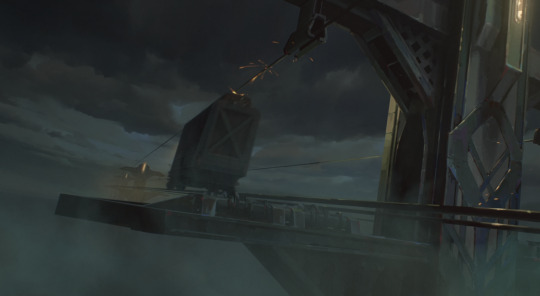
Individual train cars run on two parallel lines of… something, with an overhead line ostensibly providing electric power (there are sparks from it). The running lines are not directly supported by anything, they run between pillars in the sea, and there, they're placed on some roller structures.
The main thing that gets me about this is structural. Are these ropes or steel beams? Either way, why don't they bend?
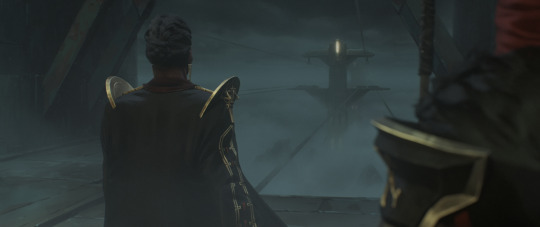
It's easy to say this is wrong and just move on, but it's more interesting to think of ways this system can make sense.
Personally, I choose to interpret it as a variation of the Aerobus design.

Picture: Rowema AG, CC-BY-SA 3.0, via Wikimedia Commons
The Aerobes is a classic gadgetbahn, a thing where an inventor said, "trains are boring, let's do a new thing that's exactly the same but proprietary, untested and less practical". In this case, it was a Swiss aerial cable car designer who came up with it. The design is that the train cars run on either two parallel steel beams or cables that are above it, and that are themselves suspended in the air. The resulting thing doesn't look too different from e.g. the Wuppertal Schwebebahn or similar systems (not that there are many), but with a much lighter infrastructure based mostly on steel ropes. Two commercial lines were built in the 1970s, one in Québec that lasted surprisingly long, one in Mannheim, Germany, for an exhibition, and that was where it stopped.
With the weird roller thing, I'm choosing to interpret this prison transport system as a similar thing. In this case the carrying rails/ropes are underneath the vehicle, but that doesn't change much. The vehicle is probably self-propelled and the rollers are just there to deal with heat expansion. I'll assume it's some magic steel so the wires don't move perceptibly as the vehicles pass over it. The vehicles themselves are only run singly, never as trains, presumably to avoid overloading the system.
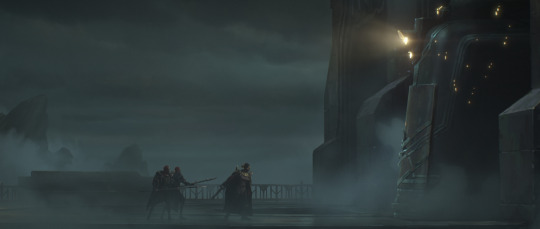
There are two vehicles, one with a ramp, one with doors that open outwards. It's possible that this represents the totality of that system. Somewhat unusually for a prison train, the system is fully automated and can be used easily by escaped prisoners and by bloodthirsty alchemical monsters trying to break in. It looks cool though.
Intermodal transport
The other rail thing I want to talk comes at the end of the show, episode 9, and here Netflix really screws me over. It was basically impossible to take screenshots, even though it worked just fine for episode 4. They ended up crazy blurry, of the wrong moment, whatever. I've been making use of Fancaps.net, whose collection is exhaustive, but sadly they tend to focus more on important character moments and cool stuff and less on rail infrastructure. So please excuse the wall of text.
At that point in the show a big invasion is happening, and our heroes are trying to defend themselves. One of the means they have is an innovative form of multimodal container transport. The shipping container is brought to the loading station by rail. From there, it is lifted by magic, through a magic gate… and then fired at high speed at the enemies. Fun!
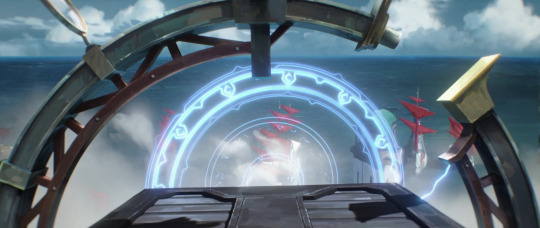
The shipping container and the flat car are both designed to be a bit fantastical, not a direct copy of our modern world, and I can respect that, even though I don't know how these angle brackets are actually supposed to hold the container in place.
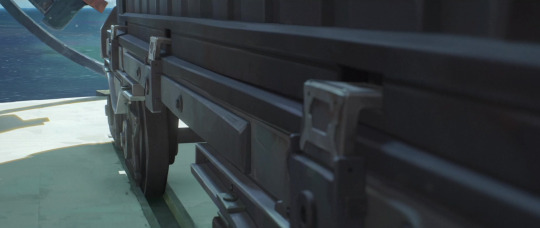
But then… look at that truck. Or bogie. I'd give you a better angle but Netflix insisted on making it blurry. Hell, I'll give it to you anyway.
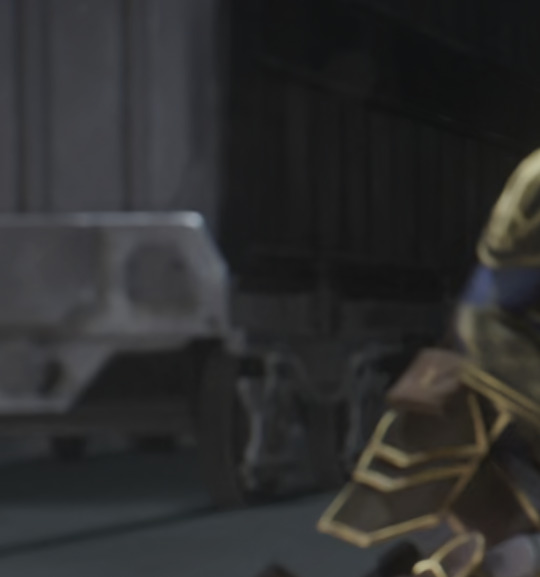
Ignore the foreground, that's just characters frantically trying to save someone's life. What's important is the railroad truck. And as you can sort of see, that's clearly a Y25!
Okay, back up a bit, let me explain. So most rail vehicles have four axles. To go around corners easily, these are not directly attached to the main body. Instead two axles in the front and two in the back are attached to a special frame that can swivel and pivot; the truck or bogie. I think one of these terms may be British and the other North American, but as someone who is neither, I don't actually know, as far as I can tell both are in use.
As the part that holds and guides the axles, provides most of the suspension, takes all of the shocks that the suspension can't, holds braking equipment and propulsion equipment, the bogie of a train is super important. There is a lot of research and development in that area, with designs being constantly refined and improved.
Except when it comes to freight cars. For freight cars, there are two bogies: The French one, used in Europe (excluding the former Soviet Union, probably Finland, and for the UK it's difficult), and the American one, used everywhere else.
This division isn't quite accurate, but it's accurate enough. It's not a law by any means, people keep inventing new trucks for freight cars all the time. But they rarely get sold much. The standard designs are good enough, they get produced in large numbers for cheap, and since they're so standardised, if you use them, you can skip a significant number of steps the approvals process that otherwise come with inventing a new type of rail vehicle.
I am somewhat lying here, in that both the French and the American design are actually large families with many different types, and I assume in particular American rail fans will be angry when I say all their bogies look the same to me… but I'm correct anyway, sorry.
I don't have any good pictures of the American style, so have one from a model railroad car instead:
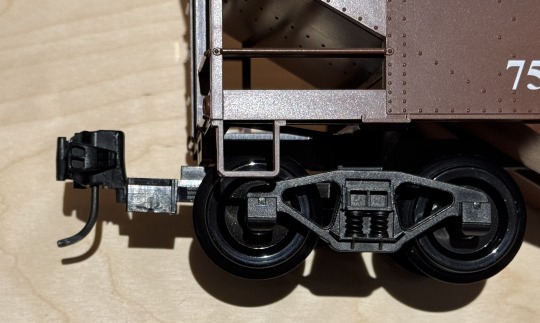
These are known as Bettendorf-style or sometimes "three piece bogie", their central part is that they have two side frames that hold the axle ends, and one central bolster connecting them. The springs are between the side parts, the bolster isn't directly fixed to them. Rides well on rough tracks, which is why you'll sometimes, rarely, see them on maintenance of way equipment in Europe (although generally beefier versions of the same design. Same in the US).
In contrast, the French version is the Y25.

It also consists of one bolster and two side frames. However, it also usually has additional relatively weak parts at the front and end. The bolster is fixed to the side frames, but it's designed to flex in itself. The springs are between the side frames and the wheel bearings. A characteristic part for the standard type is the "belly" between the wheels, and the hole in there.
Arcane is made by Fortiche, Fortiche are French, and thus their rail car gets a Y25. They spaced it up a little, and in the course removed the suspension and brakes and added a plate over the hole where the central bolster attaches, but it's still clearly a Y25 type bogie.
The rest of the track is a bit weird. The train car doesn't have flanges, instead it runs in grooves in the ground. It's also unclear how it's moved there; it seems to be some kind of winch (you need to turn a handle really hard or push the train car with superpowers). Most importantly, it's unclear why someone built a container delivery railway to the top of the city's tallest tower in the first place. But I am absolutely delighted by the Y25 freight car bogie there.
If you are interested in the wide world of freight car bogies, and you speak German, I strongly recommend Drehgestelle.de, a delightfully old-fashioned website by a single guy who really cares very much. He charts the history of the Y25, the Bettendorf bogie, the earlier Diamond bogie, the German counterpart to the Y25 that used to be popular until it got outlawed, and all the various weird other things that have been tried.
All in all, a good show, I can recommend it.
33 notes
·
View notes
Text




CSX intermodal train Deshler, Ohio.
14 notes
·
View notes
Video
287 at Nickajack por Matt Jones Por Flickr: The Southern leads Westbound intermodal train 287 through the cut at Nickajack Lake near Haletown.
6 notes
·
View notes
Video
Highball "Rye-O" by Erie Limited Via Flickr: 5360 leads a three-pack of Rio Grande tunnel motors west out of Red Narrows on the Provo Sub east of Thistle, UT. The next set of signals protect the crossovers at "Rio" and I distinctly remember hearing crews call "clear signal Rye-O" as they approached. This hot Z train carried RBLs full of Coors beer on the head end, ahead of the intermodal traffic. There doesn't appear to be one bit of graffiti on those RBLs! It was a nice touch for the crew to use the gyralight on the low nose. I imagine not many of them were still serviceable in the early aughts. UP ZDVRO: UP 5360 SD40T-2 DRGW 5410 SD40T-2 DRGW 5407 SD40T-2
14 notes
·
View notes
Text
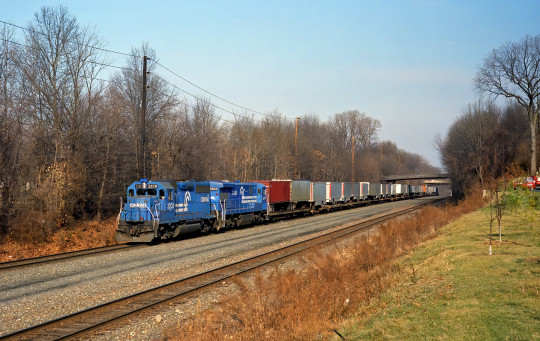
TV-80 Day
Friday was "TV-80 Day" on Conrail's River Line, so from that we can infer that December 15, 1989 was a Friday. TV-80 ran on a once-per-week schedule, departing Chicago on Thursday morning with hot UPS intermodal traffic off the Santa Fe at Corwith Yard. After setting off blocks of cars at Syracuse and Selkirk, what remained was typically a short piggyback train destined for North Bergen Yard. TV-80 is seen here hustling through Teaneck, NJ behind a GP40/C36-7 duo. The lead unit would become MEC 315 after being sold to Guilford. It was still in service as of late 2023.
Conrail TV-80: CR 3208 GP40 CR 6644 C36-7
37 notes
·
View notes
Note
Oh yeah I forgot: the silver line is even less fuckable than the orange line because it’s not even a train, it’s a bus that thinks it’s a train. Buses are not sexy.
In defense of the commuter rail, the GP40MC is a supremely beautiful woman even if she has some trouble coming in a reasonable amount of time.
Hey, we don't busshame here. Buses are very sexy. Intermodality, adaptability, lower startup capital. how do you hate on buses.
28 notes
·
View notes



